|
|
Post by Dave Homewood on Nov 26, 2019 21:14:58 GMT 12
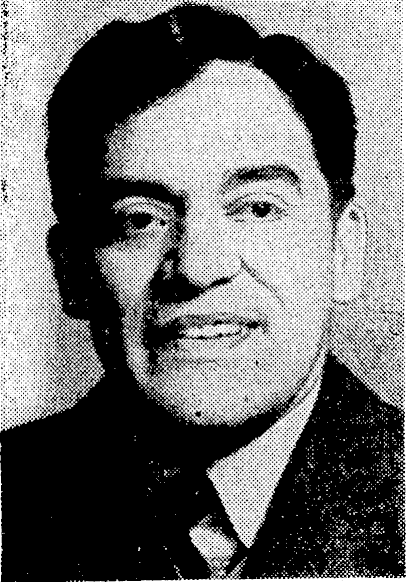 S. P. Andrew and Sons Photo. Flying Officer Kingi Tahiwi, who has been reported missing on air operations, is the only son of a well-known Wellington Maori family. He was educated at Wellington College and Victoria University, and before joining the Air Force was a popular radio announcer. EVENING POST, 20 NOVEMBER 1942 |
|
|
|
Post by ErrolC on Jun 13, 2020 9:00:42 GMT 12
|
|
|
|
Post by fwx on Jun 24, 2020 20:32:05 GMT 12
Thanks Errol and JDK, an excellent presentation and very thought-provoking.
I am currently talking to the son of a Maori Lancaster pilot and only have more admiration for those guys, the more I learn.
|
|
|
|
Post by Dave Homewood on Dec 12, 2020 15:45:34 GMT 12
|
|
|
|
Post by Dave Homewood on Dec 22, 2020 9:47:18 GMT 12
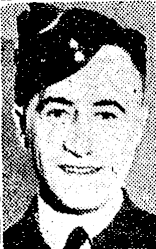 Pilot Officer Iwi Te Alka (Tuahiwi), who recently gained his commission overseas. PRESS, 12 MAY 1944 |
|
|
|
Post by Dave Homewood on May 21, 2021 22:16:33 GMT 12
‘BEST JOB OF LOT’
NEW ZEALAND AIRMEN
MORRINSVILLE PILOT
SUCCESSFUL OPERATIONS
LONDON, July 23
A Maori All Black in 1938, Sergeant J. H. Wetere. of Morrinsville, is flying a Hurricane bomber. He and Sergeant W. Tye, of Wanganui, are the only New Zealanders in the squadron, which is comprised of men from Fighting France, Belgium, Canada, Australia, the Gold Coast, Ireland and Australia.
It is called the Mauritius Squadron, because Mauritius raised the funds for Hurricanes. Sergeant Tye said: “It is the best job of the lot. There is plenty of excitement.” He has carried out five operations. Sergeant Wetere was in two divebombing raids against a shell-filling factory at Marquise, near Boulogne, while Sergeant Tye was on leave.
Sergeant Wetere said: “We arrived over the target at a height of 10,000 feet, peeled off and went into a dive at an angle of 70 degrees, working up to 400 miles an hour. I released the bombs at 1000 ft. and then carried on the dive, flattening out near the ground. I began weaving violently to escape flak and machinegun fire. I could see flak coloured red and green spurting around everywhere. I ducked down into gullies and over trees and hedges, being fired at until I reached the sea. We all hit the target. In fact, we could not miss.”
Raid on Factory
Sergeants Tye and Wetere were together in a raid against a parachute silk factory at Calais. The former, describing the venture, said: “It was a beautiful, clear day. We saw the target from half-way over the Channel, flying at 12,000 ft. We came down several thousand feet when we met a terrific flak barrage. I was weaving all the time and heard a shell burst below me and as a result a lump of shrapnel went clean through the Hurricane 2ft behind the cockpit. We did not stay long after bombing the target.”
Sergeant Wetere said: “A piece of flak went through my perspex hood inches away from my head. I heard it whistle past. I also had a piece of the tail-plane blown off. It was not so good.”
Sergeant Tye has taken part in raids against Dunkirk, where he bombed the docks and railway sidings. Also St. Omer aerodrome, where the Germans jumped on them, but the Hurricanes evaded them by turning sharply and as a result the enemy overshot. Sergeant Tye said: “We flew almost along the ground, shooting up everything we could see.”
Sergeant Wetere bombed a factory from 200 feet at Gamaches with a Canadian. This Hurricane bombing is dangerous and also exciting work. The bombers carry two 250-pound bombs and have 12 machine-guns. They are usually escorted by Spitfires. Sergeant Tye said: “It is a great sight to see the Spitfires stepped up over you, layer after layer. We usually use the plane's nose for sighting. It is a matter of judgment when you drop bombs and one must be careful not to overshoot the target.”
Good Work by Maoris
Sergeant Wetere is one of the few Maori pilots in Britain, others being Pilot-Officer Kingi Tahiwi, of Wanganui, who is flying torpedo-bombers, and Sergeant P. P. J. Pohe, of Taihape, who has completed one tour of operations. There are several Maori air-gunners in Britain.
Sergeant Wetere played regularly for the R.N.Z.A.F. Rugby team last winter. He is popular in the squadron, whose commanding officer said that both New Zealanders were good pilots and would do well. They met the Duke of Kent when he visited them recently. An interesting point about the Hurricane bomber is that it is an excellent dive-bomber, being faster than the German Stuka, while it is also a fighter. A squadron-leader observed: “I cannot understand why all this outcry for dive-bombers when we have got Hurricane bombers.”
WAIKATO TIMES, 24 JULY 194
|
|
|
|
Post by McFly on May 22, 2021 7:20:02 GMT 12
‘BEST JOB OF LOT’NEW ZEALAND AIRMEN MORRINSVILLE PILOT SUCCESSFUL OPERATIONS LONDON, July 23 A Maori All Black in 1938, Sergeant J. H. Wetere. of Morrinsville, is flying a Hurricane bomber. He and Sergeant W. Tye, of Wanganui, are the only New Zealanders in the squadron, which is comprised of men from Fighting France, Belgium, Canada, Australia, the Gold Coast, Ireland and Australia... ...Sergeant Wetere played regularly for the R.N.Z.A.F. Rugby team last winter. He is popular in the squadron, whose commanding officer said that both New Zealanders were good pilots and would do well. They met the Duke of Kent when he visited them recently. An interesting point about the Hurricane bomber is that it is an excellent dive-bomber, being faster than the German Stuka, while it is also a fighter. A squadron-leader observed: “I cannot understand why all this outcry for dive-bombers when we have got Hurricane bombers.” WAIKATO TIMES, 24 JULY 194  (Air Force Museum Collection) |
|
|
|
Post by davidd on May 22, 2021 12:52:11 GMT 12
Great photograph above of the "Hurri-bomber" being re-armed, although I guess that name came later! As these aircraft are supposed to be the 12-gun Mk. IIB, we can see the main battery (covered over with fabric patch) of four right above the armourer in centre of picture, plus one more also covered over much further out, in line with the second armourer (in shadow). So, is that the (wrapped with fabric) barrel of the sixth gun just above and to left of the 5th gun, right below the code letter (X or Y?) on fuselage behind? Also looks like a nice day out on the airfield!
David D
|
|
|
|
Post by Dave Homewood on Mar 31, 2023 10:02:59 GMT 12
There you go Dave, Pine Takarangi...  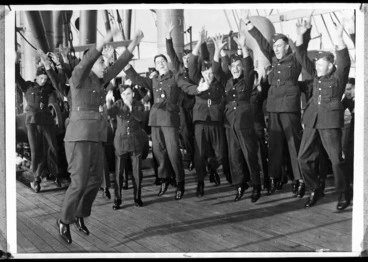 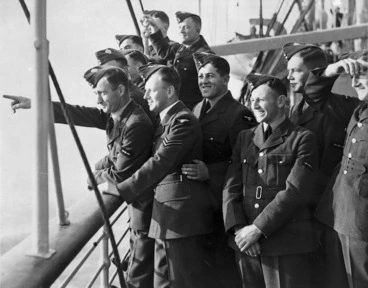 Here is an article about the men in the above photos arriving in Canada. DOMINION AIRMEN
VANCOUVER'S WELCOME THRILL FOR CANADIANS MEN SING AS SHIP BERTHS GAY SCENES AT STATION [FROM OUR OWN CORRESPONDENT] VANCOUVER, Nov. 3 As a great liner, with Australian and New Zealand airmen crowding the rails, slipped into her berth at Vancouver on a recent night, a Royal Canadian Air Force band struck up a tarara boom of welcome. As though in reply, the 1940 Anzacs broke into their new marching song, "We Are the Boys from Way Down. Under." It was thrilling, this song which the air trainees from the Antipodes roared out in splendid unison; and there was a catch in the throats of the crowd that stood on the dark dock when they heard the last line: "Sons of the Anzacs are we." Aboard the transport as she cut her way through the smooth waters, the New Zealanders in the afternoon performed a haka for the benefit of Air Commodore Earl A. Godfrey, chief of the western air command, who travelled the last leg of the journey with them. "Terrifying" Spectacle
Led by a Maori,, husky Pine Takarangi, New Zealanders slapped their knees, stretched out their arms, shadow boxed to nerve-tingling guttural yells. Then with a final shout they all leapt into the air and stuck out their tongues. It was terrifying. Later, representatives of four Royal Air Forces — those of Australia, New Zealand, Canada and Great Britain, stood in the darkness outside the pier listening to words of welcome from four of British Columbia's leading citizens. Lieutenant-Governor E. W. Hamber, standing stiffly in front of the trimly-uniformed ranks of Australian and New Zealand airmen, was the first to greet the Anzacs. "You will be received in Canada with open arms," he told them "You will soon feel you are not strangers in a strange land, but brothers in blood, brothers in arms.'' "Wish You Good Luck" The road would be hard, but there could be no doubt of ultimate victory. Germany would be defeated, disintegrated for all time. "To you who have come from Australia and New Zealand," he concluded, "Canada welcomes you and wishes you good luck and Godspeed." There was no applause. Only a murmur of approval from the ranks of civilians grouped opposite the silent ranks of uniformed men. Mr. G. G. McGeer. M.P., spoke with the voice of federal authority. He said he felt proud to be associated in a second welcome to fighting men from Australia and New Zealand. "We want to make your training period in Canada a time of happy, pleasant and profitable experience," he said. Hitler's Pagan Land "You are embarked on one of civilisation's greatest adventures," Mr. McGeer added. "By the time you have finished there will be flames all over Germany from wing to wing, from nose to tail. For every bomb that has been dropped on British soil there will be thousands of British Empire bombs blasting Hitler's pagan land. The Bosche is squealing already." Air-Commodore Godfrey struck a practical note. He assured the visiting airmen of the utmost co-operation from Canada during their period of training in Canada. He said: "I hope the spirit of goodwill and fellowship that prevailed between your personnel and ours during the last war will persist in this war." The Mayor, Mr. Telford, voiced a civic welcome. He said he believed the airmen would come to love Canada and that Canadians would have the privilege of cheering them on their victorious homeward way. Welcome Acknowledged Mr. W. A. Bundle, manager of the transportation bureau, Vancouver Board of Trade, rounded off the ceremony of welcome by leading three hearty cheers for the Australians and New Zealanders. From the ranks came polite words of acknowledgment. Leading-Aircraftsman J. Goulding, of the New Zealand Air Force, stepped briskly to the front, saluted, and in simple language conveyed thanks for the welcome given to the Anzacs. "We hope to be worthy of the confidence you have shown in us." he said. With Air-Commodore Godfrey were Wing-Commander Hal Wilson, officer commanding Jericho Beach aerodrome; Group-Captain L. M Isitt. liaison officer for the Royal New Zealand Air Force; Wing-Commander S. C. Seaville, a native of New Zealand, now a member of the British Royal Air Force; and Flight-Lieutenant James Lawson, assistant to the Australian liaison officer. Women AdmirersEscorting officers were Flight-Lieutenant H. Hooper, Australian Air Force, and Flying-Officers A. T. Grey and F. Calder, New Zealand Air Force. Members of a Canadian friendly society presented packages of cigarettes to the visiting airmen as they stepped ashore. Each packet contained a card inscribed with the insignia of the order. There were gay scenes on the station platform when the airmen boarded two special trains. A Royal Air Force band was playing "There'll Always Be An England." Groups of airmen joined hands as they sang the chorus, and women admirers clustered about them. Canadians exchanged coins with Australians and New Zealanders and civilians were entrusted with hastily-written postcards addressed to relatives "down under." There were cheers as the train-loads pulled out. Civilians sang "Wish Me Luck As You Wave Me Good-bye" and "Roll Out the Barrel." The airmen waved back until they were lost in the darkness. NEW ZEALAND HERALD, 11 NOVEMBER 1940 |
|
|
|
Post by Dave Homewood on Apr 20, 2023 19:41:29 GMT 12
MAORI AIRMEN
INCIDENT IN CANADA
SISTER'S PEN FRIEND
WARM WELCOME RECEIVED FROM TOM MOORE
(Copyright) SOMEWHERE IN CANADA. Jan. 24
Many years ago public schools in Canada joined with schools in other parts of the world in an international friendship programme. Schoolchildren throughout the world started to write letters to each other. A little Canadian girl, whose home city has now become one of the most important centres of the Commonwealth Air Training Scheme, secured the name of a New-Zealand girl and started correspondence that was kept up for a number of years. The New Zealand girl was Joy Douglas, the Canadian girl Jocelyn Wren.
When the Douglas brothers arrived in Canada, a newspaper mentioned them by name as being among a group of Maoris who were members of the Royal New Zealand Air Force who had just reached this country for further training. Jocelyn Wren's parents read the item and wondered if they might be relatives of their daughter's New Zealand correspondent of the same name.
Mr. Wren telephoned to the air training school. He was put in touch with the Douglas boys. Sure enough, Adrian and Wallace were Joy's brothers. "Why, we even have pictures of the Rocky Mountains that your daughter sent to Joy," the boys from New Zealand told Mr. Wren.
It was one of those coincidences that should happen only in story books, but it provided two Maori boys with some unexpected friends far away from home. Since their meeting, the Wrens have opened their home to the brothers.
NEW ZEALAND HERALD, 4 FEBRUARY 1941
|
|
|
|
Post by Dave Homewood on Apr 27, 2023 11:17:00 GMT 12
Portrait of World War II ace and 'perfect gentleman' Bert Wipiti unveiled at New Plymouth Boys' High SchoolHelen Harvey 05:00, Apr 27 2023  VANESSA LAURIE/STUFF Members of flying ace Bert Wipiti’s whānau, New Plymouth Boys’ High School students Coredae Wipiti- Boylan and Kace Raven, both Year 9 and Tiki Ngarangi, Year 11, helped unveil a painting of Wipiti at the school’s assembly.A World War II flying ace killed over France nearly 80 years ago was honoured at his former school on Wednesday with members of his whanau unveiling a portrait of the young fighter pilot. Former New Plymouth Boys’ High School student Bert Wipiti, (Ngāti Te Whiti), joined the Royal New Zealand Air Force and was the first Māori pilot to go overseas when he was sent to Singapore with the RAF’s no 243 squadron. The painting, by artist Matt Gauldie, was commissioned by the NZ Remembrance Army and given to the school by managing director Major Retired Simon Strombom, a former pupil. Head boy Josh Gard told the assembly Wipiti had shot down five Japanese planes in two weeks. This was quite an achievement, because Wipiti was flying a Brewster Buffalo fighter, now acknowledged as one of the worst fighter planes in WWII, he said. “That shows what an incredible pilot he was.” Whānau were present at the assembly, including some from Australia. Wipiti was the perfect gentleman, whānau spokesperson Lesley Skipper said before the assembly. “He was always so polite, modest and unassuming.”  VANESSA LAURIE/STUFF Bert Wipiti wore a non-regulation silver fern on his jacket. Painting by Matt Gauldie.He didn’t drink or smoke, “but he would go down to the local pubs and join in heartily when they sang. He’s recorded in a couple of books, by pilots who flew with him, as singing his heart out with his dark eyes flashing.” Wipiti and fellow New Zealander Charles Kronk were jointly responsible for shooting down the first Japanese aircraft over Singapore on January 10, 1942. In late March 1942, Wipiti was awarded the Distinguished Flying Medal (DFM) in recognition of his service, having shot down five Japanese aircraft. “They were only flying little wee peanuts of planes,” Skipper said. “Later he went on to become a Spitfire pilot and was flying a Spitfire when he was shot down.” Wipiti was killed in October 1943 over France while escorting a bombing raid on a power station. He was just 21 years old. Before the war Wipiti was a refrigeration lorry driver. “He was hoping to go to university. He had dreams of being a doctor and was trying to get a bit of money behind him first,” Skipper said.  VANESSA LAURIE/STUFF NPBHS head boy Joshua Gard tells Bert Wipiti’s story to the assembly. In front of him are paintings of former pupils; Major David Rawson 27 Machine Gun Battalion, Pilot Officer Martin Gilmer RNZAF lost on air operations in 1940, and Flying Officer Gerald Rawson RNZAF lost on air operations in 1943.While in Singapore Wipiti was subjected to racism. “We actually have it documented that he was nominated to take a command post, but the powers that be didn’t approve of a coloured person, I’m trying to be diplomatic, of a coloured person being in charge of their white pilots.” So, he was moved to England with the Royal New Zealand Air Force, 485 Squadron, and flew a Spitfire escorting bombers in raids across Europe. Artist Matt Gauldie, an Afghanistan veteran and former New Zealand Army painter, said Wipiti’s was a story not many people knew about. “In those days it was a very different climate for young Māori guys and for him to become a pilot he must have been quite an exceptional person and an exceptional pilot.” To do the portrait he looked at lots of photos of Wipiti, he said before the assembly. “And more importantly, had a nice chat over a cup of tea and a discussion about who he was as a person, what his aspirations were and stories about his personal life. Stuff you don’t hear about from pictures – to get some sort of insight into his character.” As a portrait painter it’s important to “get what is behind the eyes and pick up the essence of character for the portrait,” he said. “My challenge was to give the painting something else other than just what he looked liked.” The whānau asked for some things to be added in, such a little silver fern Wipiti was wearing in some of the photos. It was non-regulation, Gauldie said. “He was not supposed to be wearing it, but he chose to, so I added it in.” www.stuff.co.nz/pou-tiaki/131807886/portrait-of-world-war-ii-ace-and-perfect-gentleman-bert-wipiti-unveiled-at-new-plymouth-boys-high-school?
|
|
|
|
Post by baronbeeza on Apr 28, 2023 11:51:02 GMT 12
A little poetic licence with the ribbons.
|
|
|
|
Post by Dave Homewood on May 6, 2023 15:32:53 GMT 12
NEW ZEALAND HERALD, 18 SEPTEMBER 1941
MAORI SERGEANT
SERVED SINCE SEPTEMBER, 1939
(0.c.) WANGANUI, Wednesday
The first Wanganui Maori to serve with the Royal Air Force overseas, a member of the first party of New Zealand airmen to train under the Empire scheme in Canada, Sergeant Pine Takarangi has been reported missing on air operations, according to official advice received by his parents. Mr. and Mrs. Tenga Takarangi, Putiki. He is their only son.
Sergeant Takarangi applied for service seven months before the war and was accepted in September. 1939. After a month at the Ohakea training school he was transferred to Weraroa., where for 14 months he was on headquarters staff. He was accepted for an air crew in September, 1940. and early in the following month sailed for Canada. He gained his wings in Canada, and became a wireless operator and gunner. He arrived in England in May.
Sergeant Takarangi has six uncles serving with the forces overseas.
|
|
|
|
Post by Dave Homewood on Sept 26, 2023 0:53:22 GMT 12
I had a chap post on the wall of one of my facebook groups looking for info on Hawea Tomoana who served with 149 Squadron RAF. I sent him the link to this thread but I'm not sure if he will see it and post here. He has attached a photo to his post as well. www.facebook.com/pages/No149-Squadron-RAF/230269846999091ROLL OF HONOUR Reported missing on air operations, Sergeant Hawea Tomoana is the son of Mr. and Mrs. P. H. Tomoana, of Waipatu, Hastings. Sergeant Tomoana, who is 30 years of age, was educated at the Mangateretere and Napier High Schools and Te Aute College. He represented the Tamatea district in tennis, hockey and golf, and was also a Hawke's Bay Rugby football representative. He was a staunch worker for the Maori Mission of the Anglican Church. Alter leaving Zealand early in 1941, he completed his training in the Royal New Zealand Air Force in Canada. He then served in Great Britain, the Middle East and Kenya, and again in Great Britain, from where he was posted missing. Sergeant Tomoana was married in England to Miss Joyce Butler, of Epsom, Surrey. 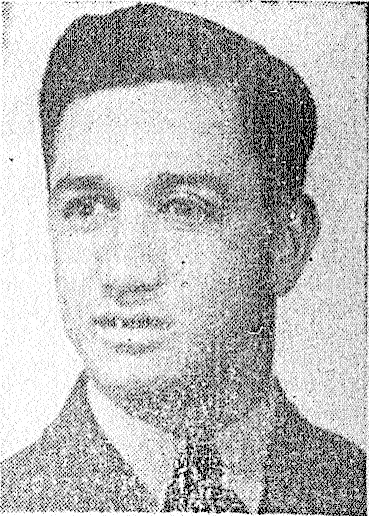 Sergeant Tomoana New Zealand Herald. 17 September 1943 |
|
|
|
Post by Antonio on Sept 26, 2023 7:56:27 GMT 12
|
|
carotc
Leading Aircraftman

Posts: 2 
|
Post by carotc on Mar 8, 2024 8:24:17 GMT 12
There you go Dave, Pine Takarangi...    Here is an article about the men in the above photos arriving in Canada. DOMINION AIRMEN
VANCOUVER'S WELCOME THRILL FOR CANADIANS MEN SING AS SHIP BERTHS GAY SCENES AT STATION [FROM OUR OWN CORRESPONDENT] VANCOUVER, Nov. 3 As a great liner, with Australian and New Zealand airmen crowding the rails, slipped into her berth at Vancouver on a recent night, a Royal Canadian Air Force band struck up a tarara boom of welcome. As though in reply, the 1940 Anzacs broke into their new marching song, "We Are the Boys from Way Down. Under." It was thrilling, this song which the air trainees from the Antipodes roared out in splendid unison; and there was a catch in the throats of the crowd that stood on the dark dock when they heard the last line: "Sons of the Anzacs are we." Aboard the transport as she cut her way through the smooth waters, the New Zealanders in the afternoon performed a haka for the benefit of Air Commodore Earl A. Godfrey, chief of the western air command, who travelled the last leg of the journey with them. "Terrifying" Spectacle
Led by a Maori,, husky Pine Takarangi, New Zealanders slapped their knees, stretched out their arms, shadow boxed to nerve-tingling guttural yells. Then with a final shout they all leapt into the air and stuck out their tongues. It was terrifying. Later, representatives of four Royal Air Forces — those of Australia, New Zealand, Canada and Great Britain, stood in the darkness outside the pier listening to words of welcome from four of British Columbia's leading citizens. Lieutenant-Governor E. W. Hamber, standing stiffly in front of the trimly-uniformed ranks of Australian and New Zealand airmen, was the first to greet the Anzacs. "You will be received in Canada with open arms," he told them "You will soon feel you are not strangers in a strange land, but brothers in blood, brothers in arms.'' "Wish You Good Luck" The road would be hard, but there could be no doubt of ultimate victory. Germany would be defeated, disintegrated for all time. "To you who have come from Australia and New Zealand," he concluded, "Canada welcomes you and wishes you good luck and Godspeed." There was no applause. Only a murmur of approval from the ranks of civilians grouped opposite the silent ranks of uniformed men. Mr. G. G. McGeer. M.P., spoke with the voice of federal authority. He said he felt proud to be associated in a second welcome to fighting men from Australia and New Zealand. "We want to make your training period in Canada a time of happy, pleasant and profitable experience," he said. Hitler's Pagan Land "You are embarked on one of civilisation's greatest adventures," Mr. McGeer added. "By the time you have finished there will be flames all over Germany from wing to wing, from nose to tail. For every bomb that has been dropped on British soil there will be thousands of British Empire bombs blasting Hitler's pagan land. The Bosche is squealing already." Air-Commodore Godfrey struck a practical note. He assured the visiting airmen of the utmost co-operation from Canada during their period of training in Canada. He said: "I hope the spirit of goodwill and fellowship that prevailed between your personnel and ours during the last war will persist in this war." The Mayor, Mr. Telford, voiced a civic welcome. He said he believed the airmen would come to love Canada and that Canadians would have the privilege of cheering them on their victorious homeward way. Welcome Acknowledged Mr. W. A. Bundle, manager of the transportation bureau, Vancouver Board of Trade, rounded off the ceremony of welcome by leading three hearty cheers for the Australians and New Zealanders. From the ranks came polite words of acknowledgment. Leading-Aircraftsman J. Goulding, of the New Zealand Air Force, stepped briskly to the front, saluted, and in simple language conveyed thanks for the welcome given to the Anzacs. "We hope to be worthy of the confidence you have shown in us." he said. With Air-Commodore Godfrey were Wing-Commander Hal Wilson, officer commanding Jericho Beach aerodrome; Group-Captain L. M Isitt. liaison officer for the Royal New Zealand Air Force; Wing-Commander S. C. Seaville, a native of New Zealand, now a member of the British Royal Air Force; and Flight-Lieutenant James Lawson, assistant to the Australian liaison officer. Women AdmirersEscorting officers were Flight-Lieutenant H. Hooper, Australian Air Force, and Flying-Officers A. T. Grey and F. Calder, New Zealand Air Force. Members of a Canadian friendly society presented packages of cigarettes to the visiting airmen as they stepped ashore. Each packet contained a card inscribed with the insignia of the order. There were gay scenes on the station platform when the airmen boarded two special trains. A Royal Air Force band was playing "There'll Always Be An England." Groups of airmen joined hands as they sang the chorus, and women admirers clustered about them. Canadians exchanged coins with Australians and New Zealanders and civilians were entrusted with hastily-written postcards addressed to relatives "down under." There were cheers as the train-loads pulled out. Civilians sang "Wish Me Luck As You Wave Me Good-bye" and "Roll Out the Barrel." The airmen waved back until they were lost in the darkness. NEW ZEALAND HERALD, 11 NOVEMBER 1940 |
|
carotc
Leading Aircraftman

Posts: 2 
|
Post by carotc on Mar 8, 2024 8:38:13 GMT 12
My uncle Terence (Terry) George Clark is the 5th from the right in the haka photo. He made friends with men he met onboard that sailing (the Aorangi) and flew with one of them Robin (Rob) Caskey in 106 Squadron. I'm not sure if Mel Banks is in this photo - he survived the war and was also a friend and in 106. Terry was KIA on W4179 on 16.9.1942 on a raid on Essen. Rob was KIA on 12.9.1942. Here's an excerpt from Terry's last letter home. The W/C was Gibson. My last trip was to “Mainz” that is “ops” I mean. My pal Rob Caskey “went for a Burton” there on the first night, so as they were going back again the next night, the wing-commander, took me along as gunner in his crew, to get revenge. We had a swell time. He made a low-level. We all felt crazy that night and didn’t give a hell for anything. We went straight through the flak dropped our stuff and then started in on the searchlights. In the finish the lights caught us and all the sh—(excuse: “flak” to you) started to come up, so we decided we had better get back for breakfast. Coming back some keen type Jerry tried to hit us with a light-gun. There he was out there by himself, doing his best for old Adolf. I kind of felt sorry for him afterwards. Still he shouldn’t have stuck his chin out.
Thanks for posting the write up about the arrival. I hadn't seen that before.
|
|
|
|
Post by Dave Homewood on Mar 8, 2024 9:08:13 GMT 12
Thanks for posting that.
|
|
|
|
Post by Antonio on Mar 8, 2024 10:57:06 GMT 12
|
|
|
|
Post by Dave Homewood on Nov 14, 2024 21:48:54 GMT 12
Does anyone know who F.W.B. George was? He looks like he may have been a Maori or Polynesian? CHARITY DAY RUGBY FOOTBALL.—F. W. B. George, an Air Force forward, takes vigorous measures in trying to stop a Sydenham loose rush in the principal Charity Day match at Lancaster Park on Saturday. Sydenham, runner-up in the senior competition, won by 9 points to 6. The Press, 15 August 1938 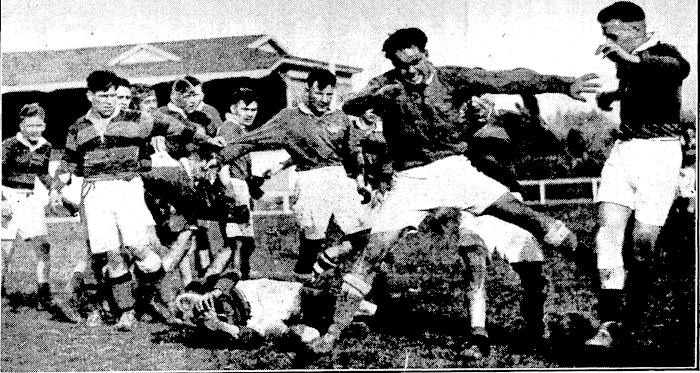 |
|



